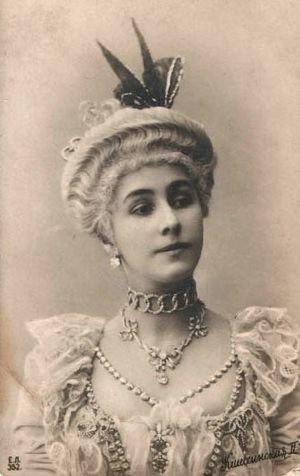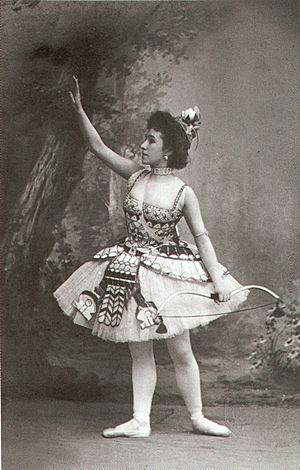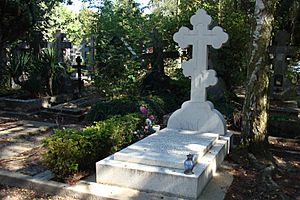Mathilde Kschessinska facts for kids
Quick facts for kids Mathilde Kschessinska |
|
|---|---|
| Princess Romanovskaya-Krasinskaya | |

Kschessinska costumed for the title role in Petipa's La Camargo. St. Petersburg, c. 1902
|
|
| Born | 31 August 1872 Ligovo, Petergof, Russian Empire |
| Died | 6 December 1971 (aged 99) Paris, France |
| Burial | Sainte-Geneviève-des-Bois Russian Cemetery |
| Spouse |
Grand Duke Andrei Vladimirovich of Russia
(m. 1921; d. 1956) |
| Issue | Prince Vladimir Romanovsky-Krasinsky |
| House | Holstein-Gottorp-Romanov |
| Father | Feliks Krzesiński |
| Religion | Russian Orthodox (previously Catholic) |
| Occupation | Prima ballerina |
Mathilde-Marie Feliksovna Kschessinska (Polish: Matylda Maria Krzesińska, Russian: Матильда Феликсовна Кшесинская; 31 August [O.S. 19 August] 1872 – 6 December 1971; also known as Princess Romanovskaya-Krasinskaya after her marriage) was a Polish ballerina from the noble family Krzesiński. Her father Feliks Krzesiński and her brother both danced in Saint Petersburg. She was a mistress of the future Tsar Nicholas II of Russia prior to his marriage, and later the wife of his cousin Grand Duke Andrei Vladimirovich of Russia.
She was known in the West as Mathilde Kschessinska or Matilda Kshesinskaya.
Contents
Early life
Kschessinskaya was born at Ligovo, near Peterhof, the youngest child of Adam-Felix Kschessinsky (Polish: Adam Feliks Krzesiński) and Julie Kschessinska. Her Polish father arrived in St. Petersburg on 30 January 1853, one of five Warsaw mazurka dancers invited by the Tsar, where he performed in the Mariinsky Theatre. In 1880, at the age of eight, Mathilde entered into the Imperial Theatre School, where she studied under Yekaterina Vazem, and was inspired by Virginia Zucchi. On 30 August 1881, she danced for the first time on the Grand Theatre stage in the ballet Don Quixote. Kschessinskaya's graduation exam dance was the pas de deux from La Fille Mal Gardée, to the music of Stella Confidenta. The performance was attended by Tsar Alexander III of Russia and the rest of the Imperial family, including Nicholas Alexandrovich, Tsesarevich of Russia. After the performance, the Tsar sought her out and said, "Be the glory and the adornment of our ballet." On 22 April 1890, she made her debut on stage, performing the same dance for Papkov's farewell, and graduated at the age of eighteen.
Prima ballerina
In 1896, she obtained the rank of Prima ballerina of the Saint Petersburg Imperial Theatres. The old maestro Marius Petipa did not consent to Kschessinskaya receiving such a title and although she possessed an extraordinary gift as a dancer, she obtained it primarily via her influence at the Imperial Russian Court.
Relationship with Petipa
According to Mathilde, "My whole artistic career, until Fokine's appearance, had been linked with Petipa. The success of his ballet, La Fille du Pharaon, which was, as I have said, to become my favourite role, had at once assured him fame in Russia. where he came on May 24th 1847, invited by the Imperial Theatres Administration, after working several years in Spain." Petipa created roles for Kschessinskaya in Le Réveil de Flore (1894), Mlada (1896), Le Roi Candaule (1897), Les Aventures de Pélée (1897), The Pharaoh's Daughter (1898), Harlequinade (1900), and La Esmeralda (1899). She also mastered the 32 fouettés en tournant of Legnani.
In 1899, Prince Serge Wolkonsky became Director of the Imperial Theaters, succeeding Ivan Vsevolozhsky. Although he held the position only until 1902, he achieved a great deal. Sergei Diaghilev was his immediate assistant, and Wolkonsky entrusted him with the publication of the Annual of the Imperial Theaters in 1900. During this period, new names appeared in the theaters, such as painters Alexandre Benois, Konstantin Somov, and Léon Bakst. However, Wolkonsky was forced to send in his resignation after clashing with Kschessinskaya when she refused to wear the panniers of an 18th-century costume in the ballet La Camargo. In 1901, he was succeeded by V.A. Teliakovsky.
Finances
Through her aristocratic connections, she managed to amass much valuable property in the Russian capital. The Bolsheviks took over her house soon after the February Revolution. It was here that Vladimir Lenin addressed a meeting of the Petrograd Bolsheviks, shortly after he had addressed the crowd at the Finland Station when he returned in 1917. She claims in her memoirs that they turned it into a kind of pigsty; she went to court to recover it, only to receive death threats; once she passed near the house, she saw Alexandra Kollontai in the garden wearing one of her overcoats. The Bolsheviks were forced to abandon the house only after the July Days.
Move to France
Kschessinska was forced to flee her home, with her son Vova, on 27 February 1917 (Old Style), during the February Revolution. Her home occupied by the Bolsheviks, Kschessinska wrote, "And Petrograd was a nightmare world of arrests, the assassination of officers in the streets, arson, pillage...". After staying with friends and relatives for a time, she left Petrograd on 13 July, ending up in Kislovodsk with Andre. On 30 December 1919, the White Army no long able to stop the Red invasion of the Caucasus, she was forced to flee to Novorossiysk. On 13 February 1920, Mathilde, Vova, and Andre boarded a Lloyd Triestino liner, leaving behind Russian soil. On 12 March 1920, they arrived at Kschessinska's Cap-d'Ail villa.
On 30 January 1921, Andre and Mathilde were married at the Russian Church in Cannes. According to Kschessinska, the Grand Duke Kirill Vladimirovich of Russia "bestowed on me the name of Krassinsky, with the title of Princess. Our son was similarly given the title Prince." In 1935, due to their Morganatic marriage, they added the name Romanovsky, and Romanov was added to their son's.
On 9 December 1925, she converted from the Catholic Church to the Russian Orthodox Church. On 5 February 1929, they moved into their Paris home. On 26 March, Kschessinska opened a dance studio, and gave her first lesson on 6 April. By 1933, she had over a hundred students, boys and girls. Her students included Tatiana Riabouchinska, Pearl Argyle, Andrée Howard, June Brae, Margot Fonteyn, Pamela May, Harold Turner, and Diana Gould. On 14 June 1936, she made her last appearance on stage at the age of 64, a jubilee performance at Covent Garden.
In 1960, she published an autobiography entitled Souvenirs de la Kschessinska (published in English as Dancing in St. Petersburg: The Memoirs of Kschessinska). In later years, she suffered financial difficulties but remained indomitable. She died in Paris, in her 100th year. She is buried at the Sainte-Genevieve-des-Bois Russian Cemetery with her husband and son.
Cultural depictions
- Fall of Eagles, 13-part television drama created by John Elliot for the BBC; portrayed by Jan Francis (1974).
- Anna Pavlova, film by Emil Loteanu; portrayed by Natalya Fateyeva (1983).
- Matilda, film by Aleksey Uchitel; portrayed by Michalina Olszańska (2017).
- Untitled Matilda Kshesinskaya project, written by Paul Schrader (TBA).
See also
 In Spanish: Mathilde Kschessinska para niños
In Spanish: Mathilde Kschessinska para niños
- List of Russian ballet dancers
Autobiography
- H.S.H. The Princess Romanovsky-Krassinsky. Dancing in Petersburg — London, 1960, 1973.
- S.A.S. La Princesse Romanovsky-Krassinsky Souvenirs de la Kschessinska — Paris, 1960.



